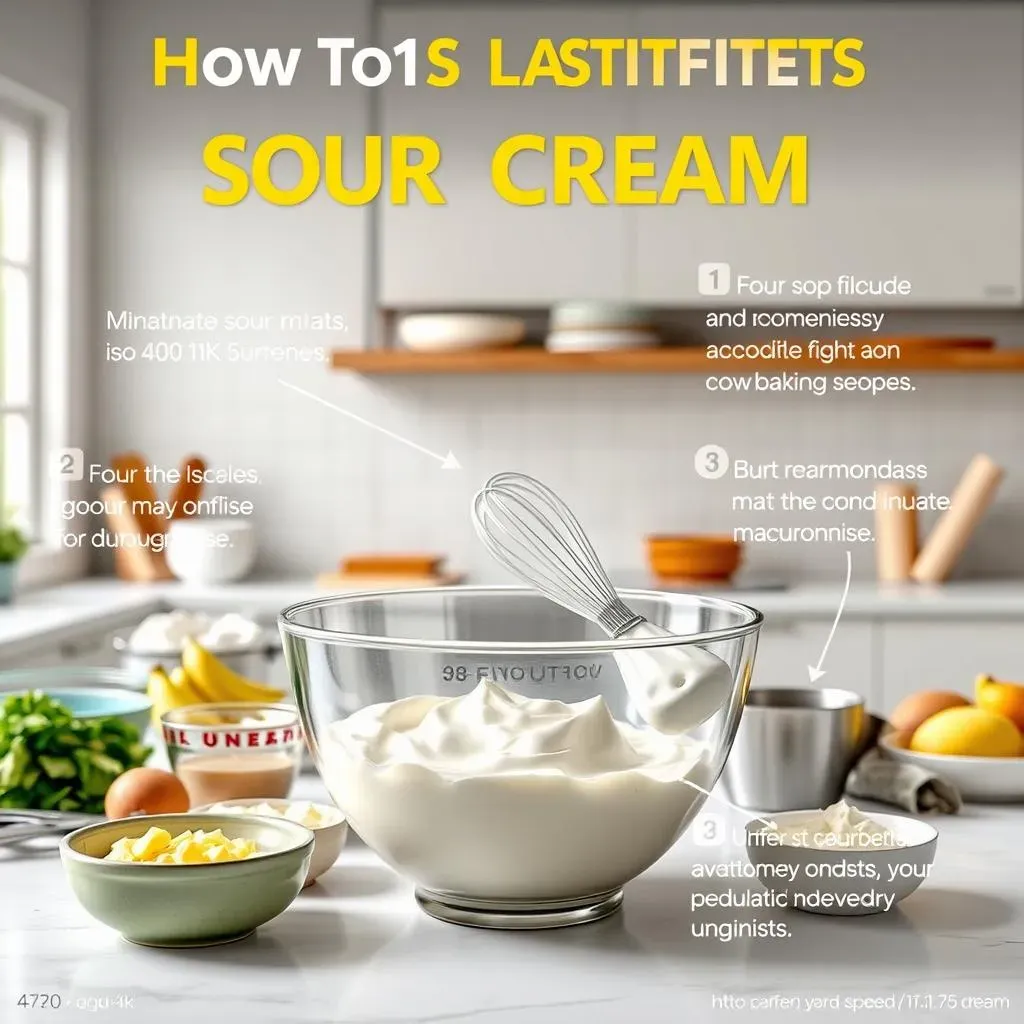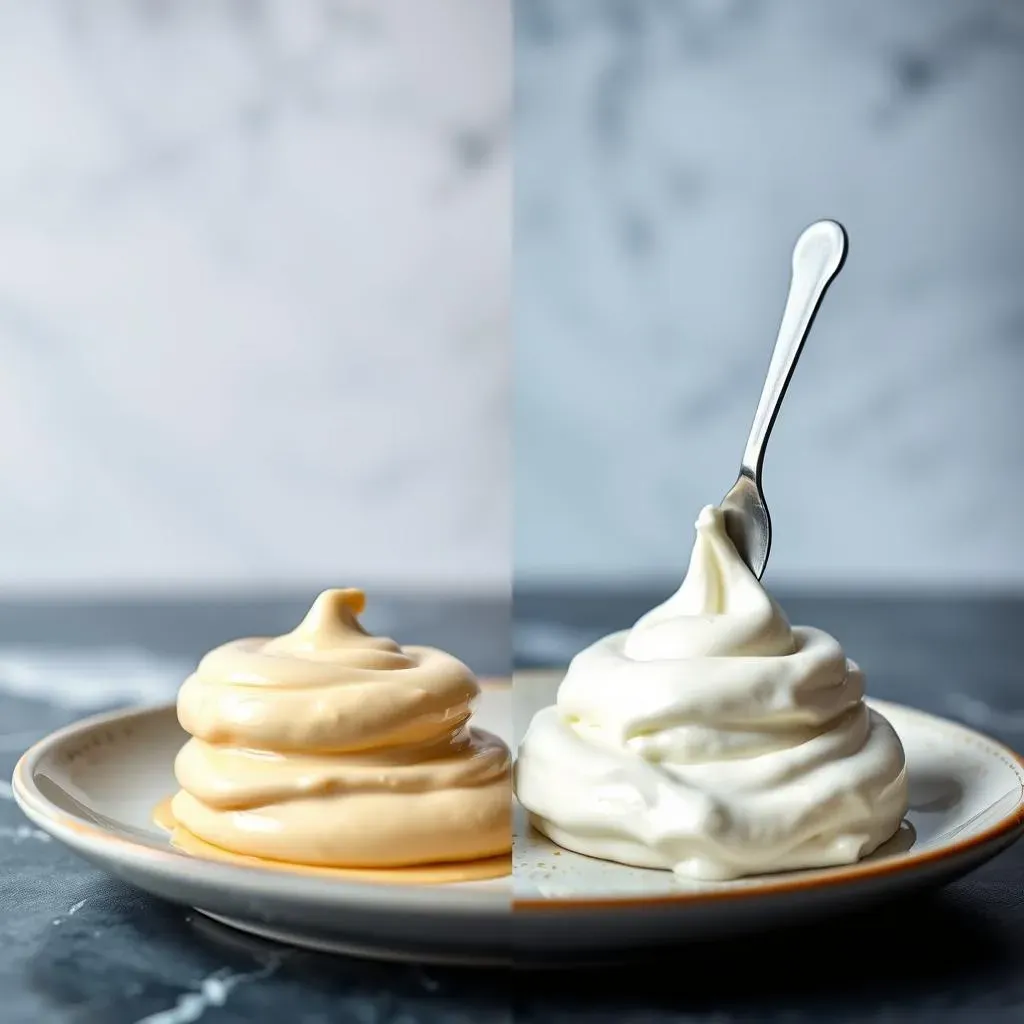Table of Contents
Ever stared into your fridge, recipe in hand, only to discover you’re out of sour cream? It's happened to the best of us. You're about to make that creamy dip, or that fluffy cake, and then BAM! No sour cream. Panic sets in, but hold on a minute, don't reach for your car keys just yet. There's a kitchen superhero hiding in your condiment collection: mayonnaise. Yes, you heard right. You can often substitute mayonnaise for sour cream, and sometimes it's a pretty good swap. But before you go slathering mayo on everything, let's get real about when and how to make this substitution. This article will guide you through the ins and outs of using mayo as a stand-in for sour cream, covering everything from baking to dips, and even what to expect in the taste department. So, if you’re ready to learn this kitchen hack, let’s get started, and maybe, just maybe, you’ll never be caught short on sour cream again.
When to Substitute Mayonnaise for Sour Cream

When to Substitute Mayonnaise for Sour Cream
The Basics: Mayo as a Sour Cream Stand-In
Okay, so you're staring at a recipe calling for sour cream, and all you've got is mayo. Don't sweat it. The good news is, mayonnaise can often pinch-hit for sour cream, especially when you're looking for that creamy texture. They both bring a richness to the table, thanks to their fat content. Think about it: mayo is basically an emulsion of oil and egg yolks, while sour cream is fermented dairy. The key difference? That tangy kick sour cream has. Mayo won't bring the same sour note, but it can still work wonders. It's like swapping a guitar for a keyboard in a song; you might lose some twang, but you can still make music.
However, it's not a perfect one-to-one swap in every situation. If the sour flavor is a key component of your dish, then using mayonnaise alone might leave things tasting a bit flat. But, for many recipes where the main goal is to add moisture and a creamy mouthfeel, mayonnaise is a solid option. Let's say you're making a potato salad; mayo will do the job. But, if you are making a stroganoff, you might miss the sour cream's tang.
Baking: Where Mayo Shines
In the baking world, mayo can be a surprisingly good substitute for sour cream. Cakes, muffins, and even some quick breads can benefit from the moisture and fat that mayonnaise provides. The fat in mayonnaise helps to create a tender crumb, while its emulsified nature can contribute to a more even texture. It's especially useful in recipes where you want a moist, dense result. Think of it like adding a secret ingredient that keeps your baked goods from drying out, it's not magic, it's just fat and moisture working in harmony.
I remember one time I was making a chocolate cake, and I was completely out of sour cream. I was about to give up, but then I thought, "Why not try mayonnaise?". The result was a cake that was so moist and delicious, I couldn't believe it. It was almost like a cheat code for baking, and now it’s my go-to when I’m in a pinch. So, next time you’re baking, don't be afraid to grab that jar of mayo. Just remember, it's best in recipes where the sour taste isn't the star of the show.
Use Case | Why it Works | Consideration |
|---|---|---|
Cakes | Adds moisture and tenderness | May not provide tang |
Muffins | Improves texture and crumb | Best in non-tangy recipes |
Quick Breads | Keeps things moist | Avoid if sour flavor is needed |
Dips and Dressings: Proceed with Caution
Now, when it comes to dips and dressings, this is where you need to tread a bit more carefully. While mayo can provide the creamy base you're looking for, it won't bring the same tang as sour cream. If you're making a dip where the sour cream flavor is essential, such as a classic French onion dip, mayonnaise alone might not cut it. It's like trying to make lemonade without lemons; you’ll get something, but it won’t be the same.
However, you can get creative. If you need that tang, try adding a splash of lemon juice or a dash of vinegar to your mayonnaise. This can help to mimic the sourness of sour cream. Also, consider mixing it with a bit of plain yogurt or buttermilk for a more complex flavor profile. It’s not going to be a perfect match, but with some adjustments, you can create a pretty decent substitute. Just remember, taste as you go, and adjust as needed. Think of it as a culinary experiment, where you're the scientist and your taste buds are the lab equipment.
How to Substitute Mayonnaise for Sour Cream in Baking and Cooking

How to Substitute Mayonnaise for Sour Cream in Baking and Cooking
The Golden Rule: Equal Parts
Alright, let's talk about the nitty-gritty of swapping mayo for sour cream. The simplest rule of thumb? Use equal parts. If your recipe calls for one cup of sour cream, use one cup of mayonnaise. It's that straightforward for most cases, especially in baking. This one-to-one ratio helps maintain the correct moisture and fat balance, which is crucial for a good end result. It’s like following a map; if you stick to the directions, you’re more likely to reach your destination. And in this case, your destination is a delicious cake or muffin.
However, remember that mayonnaise is more dense than sour cream. This might impact the texture slightly, especially in delicate recipes, this is not a big deal. If you're a baking purist, you might notice a minor difference in the end product, but for the most part, it's a negligible difference. And let's be honest, who has time for perfection all the time? Sometimes, good enough is just perfect, especially when you're in a pinch and need to use what you have on hand. It’s all about being resourceful in the kitchen.
Adjusting for Flavor
Now, we've already talked about the tangy difference between sour cream and mayo. So, what do you do when the recipe needs that sour kick? Well, you can play kitchen chemist a little bit. The most straightforward method is to add a touch of acidity. A squeeze of lemon juice, a splash of white vinegar, or even a dash of apple cider vinegar can do the trick. Start small, taste, and add more as needed. It's like adding salt to a dish; you can always add more, but you can't take it away.
Another option is to blend your mayo with other ingredients. For example, mixing mayo with a bit of plain yogurt or buttermilk can help to mimic the flavor profile of sour cream more closely. This also gives you a lighter texture, which can be beneficial in some recipes. It’s like creating a flavor orchestra, where each ingredient plays its part to create a harmonious symphony of taste. Don't be afraid to experiment and find what works best for your taste buds and your recipe.
Flavor Adjustment | How to Use | When to Use |
|---|---|---|
Lemon Juice | Add a squeeze at a time | For a bright, citrusy tang |
White Vinegar | Add a dash at a time | For a sharper, cleaner tang |
Buttermilk | Mix with mayo in equal parts | For a milder, more complex tang |
Cooking Considerations
In cooking, the principles are much the same as in baking, but with a few extra things to keep in mind. When substituting mayo for sour cream in sauces or soups, remember that mayonnaise can break down when heated too much or too quickly. To prevent this, add it at the end of cooking, or temper it by mixing it with a small amount of the hot liquid before adding it to the main dish. It’s like easing someone into a cold pool; you don’t want to shock them with the temperature.
Also, consider the richness of the mayo. It can make dishes a little heavier than sour cream would. If you are looking for a lighter result, mix mayo with yogurt or buttermilk. This will lighten the texture and add some of the missing tang. Remember, cooking is all about adapting and experimenting. So, don’t be afraid to get creative and find what works best for you. It’s your kitchen, your rules.
The Taste Test: Mayonnaise vs. Sour Cream

The Taste Test: Mayonnaise vs. Sour Cream
The Flavor Showdown
Alright, let's get down to the nitty-gritty: how do mayonnaise and sour cream stack up in a taste test? The biggest difference you'll notice right away is the tang. Sour cream has that signature sourness, thanks to the lactic acid produced during fermentation. Mayonnaise, on the other hand, is creamy and rich, but it lacks that specific zing. It’s like the difference between a lemon and a lime; both are citrus, but they bring different flavor notes to the party. If you’re making something where that tangy flavor is crucial, like a creamy coleslaw or a dill dip, you might find that mayo alone isn’t quite enough. But, if you’re using it as a binder in a tuna salad or as a moistener in a chocolate cake, the difference is less noticeable. It's all about understanding the role each ingredient plays in your recipe.
Think of it this way: sour cream is like that friend who always tells it like it is, with a bit of a sassy attitude. Mayonnaise, on the other hand, is the smooth operator, always there to add a bit of richness and texture. They both have their place, but they’re definitely not interchangeable in every scenario. I remember one time I tried to make a key lime pie with mayonnaise instead of sour cream, and let’s just say, it was not a success. The tang was completely missing, and it tasted… well, not like key lime pie. That was a lesson learned the hard way. So, while mayo is a great substitute in many cases, it’s essential to understand its limitations.
Characteristic | Sour Cream | Mayonnaise |
|---|---|---|
Tanginess | High | Low |
Creaminess | Medium | High |
Richness | Medium | High |
Texture and Consistency
Beyond flavor, texture is another key difference between mayonnaise and sour cream. Sour cream has a thicker, more viscous consistency, while mayonnaise tends to be smoother and more emulsified. This means that mayo can sometimes make a dish feel heavier or more dense than sour cream would. In some recipes, this isn't a big deal, it might even be desirable, like in a rich, decadent cake. But, in others, it can make a noticeable difference. For example, if you’re making a light, fluffy dip, you might find that mayonnaise makes it too heavy. It’s like the difference between a light summer dress and a heavy winter coat; both serve a purpose, but they feel completely different.
So, when you’re considering substituting mayo for sour cream, think about the texture you want to achieve. If you’re looking for a lighter, more airy result, then you might want to adjust your recipe accordingly. Perhaps mixing your mayo with yogurt or buttermilk, as we mentioned earlier, could help you get closer to the desired consistency. It's all about knowing what you're aiming for and making adjustments as needed. It's like being a sculptor; you start with a basic material, but you shape it to create the final result. And in this case, your final result should be delicious.
Wrapping Up: The Mayo-Sour Cream Swap
So, can you substitute mayonnaise for sour cream? The short answer is: often, yes, but with a few caveats. It's a handy trick for when you're in a pinch, especially in baking and some dips. Just remember that mayo lacks that signature tang and might alter the final flavor profile. Taste as you go, and don't be afraid to experiment. This substitution isn't always perfect, but it's a great way to keep cooking when you're missing a key ingredient. Now go forth and conquer your kitchen, armed with this newfound knowledge of the mayo-sour cream swap. You're officially ready for any sour cream emergency that comes your way!